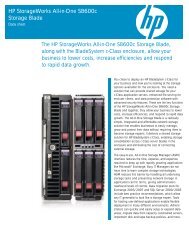HP BladeSystem Family guide
HP BladeSystem Family guide
HP BladeSystem Family guide
Create successful ePaper yourself
Turn your PDF publications into a flip-book with our unique Google optimized e-Paper software.
Step 7: choose your power and cooling configurations<br />
Save power every second with power configurations and redundancy levels to suit your needs.<br />
<strong>HP</strong> Thermal Logic capabilities<br />
Active Cool Fans<br />
Parallel Redundant Scalable<br />
Enclosure Cooling design (PARSEC)<br />
Instant Thermal Monitoring<br />
Power pooled for true N+N<br />
power redundancy<br />
Dynamic Power Saver Mode<br />
Power Regulator<br />
Power workload balancing<br />
Delivers both high airflow and high pressure in a small size that can scale to meet future cooling needs. This<br />
technology provides the ability to optimize airflow, reduce power draw, and improve acoustic performance for<br />
any server blade configuration.<br />
A hybrid model for cooling that combines the best of local and centralized cooling in a single system to offer<br />
more effective airflow and cooling for all servers. Server blades get more cooling airflow where it is needed most<br />
and use less power than traditional rack servers.<br />
Provides a real-time view of heat, power and cooling data. If the enclosure’s thermal load increases, the Onboard<br />
Administrator’s thermal logic feature instructs the fan controllers to increase fan speeds to accommodate the<br />
additional demand. Even better, it works in reverse, using all the features of Thermal Logic to keep fan and system<br />
power at the lowest level possible. Onboard Administrator monitors the thermal conditions on the hardware in<br />
real-time, without a delay for a polling cycle.<br />
All the power in the enclosure is provided as a single pool that any blade can access, providing increased<br />
flexibility when configuring the power in the system so that customers can choose what level of redundancy<br />
with which to operate. Because this power design has no zones, it facilitates both N+N and N+1 power<br />
modes, which future-proofs the enclosure for higher power requirements, if needed.<br />
Provides power load shifting for improved efficiency and reliability, it improves power supply efficiency to provide<br />
real customer power savings and, therefore, money savings. When enabled through Onboard Administrator, the<br />
total enclosure power consumption is monitored in real-time and automatically adjusted with changes in demand.<br />
Provides Integrated Lights-Out-controlled speed stepping for Intel x86 processors. The Power Regulator feature<br />
improves server energy efficiency by giving CPUs full power for applications when they need it and reducing<br />
power when they do not.<br />
Power workload balancing improves performance per watt used and uses the <strong>HP</strong> Power Regulator technology to<br />
manage power at the enclosure level, so that power usage stays within defined power caps. Using power caps,<br />
system administrators can constrain the most BTUs per enclosure and rack to enable the enclosure to fit in an<br />
existing rack power envelope. A simple power cap will allow devices to power on until power usage reaches the<br />
specified power cap and then will prevent any more devices from powering on.<br />
Blades use less energy than traditional rack servers. A<br />
lot less. <strong>HP</strong> believes you shouldn’t compromise anything<br />
to save energy. From dynamic data center cooling<br />
solutions to thermal service expertise, <strong>HP</strong> delivers a<br />
total solution to power and cooling.<br />
With built-in instrumentation, accurate monitoring and<br />
control, and the ability to pool, share and allocate<br />
the right amount of power and cooling to match your<br />
demand, <strong>HP</strong> Thermal Logic keeps your blade solution<br />
from wasting a watt of power or a gram of air.<br />
To help determine how much power your <strong>BladeSystem</strong><br />
c-Class enclosure will draw, <strong>HP</strong> provides an easy to use<br />
power sizing tool at<br />
www.hp.com/go/bladesystem/powercalculator.<br />
For more detailed information on how to plan and<br />
configure power for a <strong>BladeSystem</strong> c-Class installation,<br />
see the site planning <strong>guide</strong> at<br />
www.hp.com/go/bladesiteplanning.<br />
For more information, visit www.hp.com/go/bladesiteplanning.<br />
13



